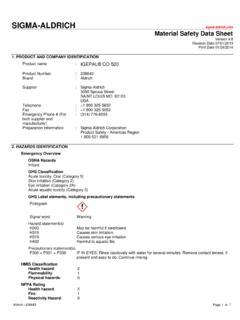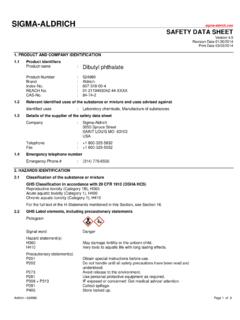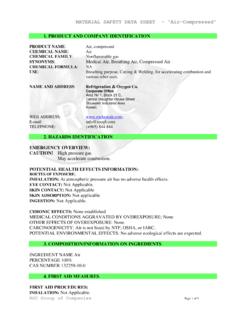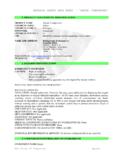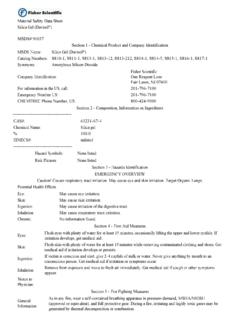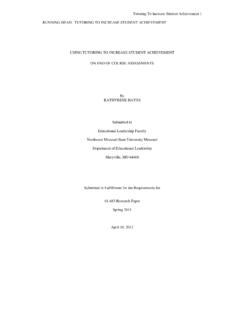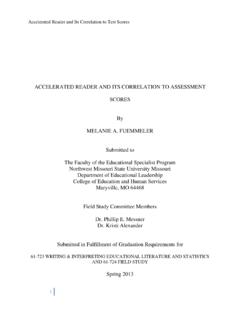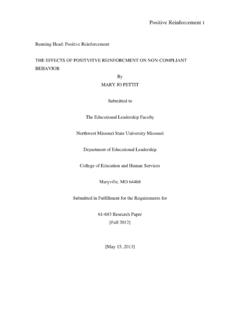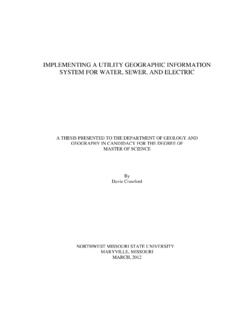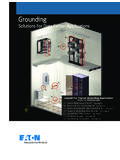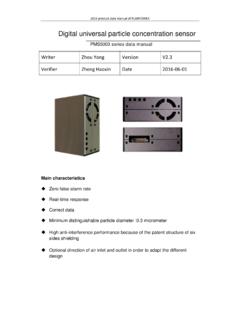Transcription of Page 1 3 BRASS ALLOYS MATERIAL SAFETY DATA SHEET
1 Page 1 of 3. BRASS ALLOYS MATERIAL SAFETY data SHEET . MATERIAL IDENTIFICATION AND USE. SUPPLIER: RUSSEL METALS INC. MATERIAL NAME: BRASS ALLOYS . ADDRESS: 1900 MINNESOTA COURT, MISSISSAUGA, SYNONYMS: Includes all products, Bar, Plate ONTARIO. CANADA. L5N 3C9. and Tubular Products. TEL: 905-819-7295. WHMIS CLASS: D2A, D2B FAX: 905-819-7262. FORM #: MSDS-07-2011. DATE: NOVEMBER, 2011. 1. PRODUCT INFORMATION. MATERIAL NAME: BRASS ALLOYS . FORM #: MSDS-07-2011 DATE: NOVEMBER, 2011. MATERIAL USE: MANUFACTURE OF ARTICLES. 2. HAZARDOUS INGREDIENTS.
2 BASE METAL (ALL VALUES ARE EXPRESSED AS WEIGHT PERCENT AND ARE APPROXIMATES). The exposure limit for copper-containing fumes has been established at mg/m3 with ACGIH's TWA. The individual complex compounds within the fume may have lower exposure limits than the general fume. COMPONENT NUMBER TLV (ACGIH - mg/m3) LD50 % WEIGHT. COPPER 7440-50-8 (Dust) U (Fume). ZINC 7440-66-6 (as Zinc Oxide - Respirable) U Up to TIN 7440-31-5 (Metal or Oxide) U Up to LEAD 7439-92-1 (Elemental & Inorganic Compounds U Up to as Lead). 3. HAZARDS IDENTIFICATION.
3 GENERAL: BRASS ALLOYS in their usual solid form and under normal conditions do not present an inhalation, ingestion, or contact health hazard or fire or explosion hazard. Operations such as welding, brazing, burning, grinding, cutting, heat treating, machining or similar operations may generate dusts, fumes and machine turnings that may create a health or fire or explosion hazard. ROUTES OF ENTRY: None in its natural solid state. High concentrations of dusts or fumes may cause irritation to the eyes. Inhalation of metal fumes or dusts generated during welding, burning, grinding or machining may cause irritations of the respiratory tract.
4 Flu-like symptoms such as fever and chills may occur a few hours after excessive exposure. Dusts or fumes can cause irritation to the skin with itching, dermatitis may occur. TARGET ORGANS: Respiratory system, kidney, liver, central nervous system, eyes and skin. EFFECTS OF ACUTE EXPOSURE TO MATERIAL : COPPER & ZINC (as Oxide): Inhalation overexposure to copper or zinc oxide may cause metal fume fever characterized by fever and chills ( flu-like symptoms) which appear 4-6 hours after exposure with no long- term effects. EFFECTS OF CHRONIC EXPOSURE TO MATERIAL : LEAD: Chronic exposures may cause lead poisoning that can affect the digestive system, nervous system, reproductive systems, muscles and joints.
5 IARC lists lead and its inorganic compounds under its Group 2B. category - possibly carcinogenic to humans . TIN: Inhalation overexposures may cause a benign pneumoconiosis (stannosis) with few or no symptoms, which is reported not to be disabling. NOTES: International Agency for Research on Cancer (IARC) - Summaries & Evaluations (2008). 3rd Annual Report on Carcinogens as prepared by the National Toxicology Program (NTP). 4. FIRST AID MEASURES. EYES: FLUSH EYES WITH PLENTY OF WATER FOR AT LEAST 15 MINUTES, HOLDING EYE LIDS OPEN.
6 SEEK MEDICAL ATTENTION IF EYE IRRITATION PERSISTS. SKIN: MAINTAIN GOOD PERSONAL HYGIENE. WASH AFFECTED AREA WITH MILD SOAP AND WATER. SEEK MEDICAL ATTENTION IF SKIN IRRITATION PERSISTS. INHALATION: REMOVE TO FRESH AIR. CHECK FOR CLEAR AIRWAY, BREATHING AND PRESENCE OF PULSE. IF NECESSARY ADMINISTER CPR. CONSULT A PHYSICIAN IMMEDIATELY. INGESTION: RARE IN INDUSTRY. DUST MAY IRRITATE MOUTH AND GASTROINTESTINAL TRACT. IF INGESTED, SEEK MEDICAL ATTENTION PROMPTLY. 5. FIRE FIGHTING MEASURES. FLAMMABILITY CLASSIFICATION: Non-flammable.
7 Will not support combustion. MEANS OF EXTINCTION: Not applicable for solid product. Use extinguishers appropriate for surrounding materials. Page 2 of 3. BRASS ALLOYS MATERIAL SAFETY data SHEET . FLASH POINT ( C): N/A AUTO-IGNITION TEMP ( C): N/A. UPPER FLAMMABLE LIMIT % BY VOL.: N/A LOWER FLAMMABLE LIMIT % BY VOL.: N/A. SENSITIVITY TO STATIC DISCHARGE: N/A EXPLOSION data (SENSITIVITY TO IMPACT): No HAZARDOUS COMBUSTION PRODUCTS: At temperatures above the melting point, fumes containing metal oxides and other alloying elements may be liberated.
8 UNUSUAL FIRE HAZARDS: Finely divided particles or dusts such as those produced during grinding may present an explosion hazard, and should be treated as a Class D combustible metal fire use a use Class D fire extinguishers (dry powder or sand). for fires involving powders or dusts. SPECIAL FIRE FIGHTING: Do not use water on molten metal. 6. ACCIDENTAL RELEASE MEASURES. LEAK AND SPILL PROCEDURES: Not applicable to BRASS ALLOYS in solid state. For spills involving fine dusts, remove by vacuuming or wet sweeping methods to prevent spreading of dust.
9 Do not use compressed air to clean spills of dusts. Avoid inhalation of dusts. Collect spilled materials into suitable labelled containers for disposal. 7. HANDLING AND STORAGE. HANDLING: Operations with the potential for generating high concentrations of airborne particulates should be evaluated and controlled as necessary. Practice good housekeeping. Avoid breathing metal fumes and/or dust. STORAGE: Store away from oxidizers, acids and other incompatible materials. 8. EXPOSURE CONTROLS. ENGINEERING CONTROLS: ( ventilation, enclosures, specify) General or local exhaust during welding, grinding or other dust generating operations.
10 PERSONAL PROTECTIVE EQUIPMENT: Dependent upon process being performed on MATERIAL each operation must be addressed for suitable equipment. GLOVES (Specify): Wear gloves as required. EYES (Specify): SAFETY glasses or goggles as required. CLOTHING (Specify): N/A FOOTWEAR (Specify): N/A. RESPIRATOR (Specify): If concentrations exceed established limits (up to 10X TLV) use NIOSH/MSHA approved particulate respirators (dust & fume or high efficiency dust & fume cartridge) when grinding or welding. OTHER (Specify): N/A. 9. CHEMICAL AND PHYSICAL PROPERTIES.
